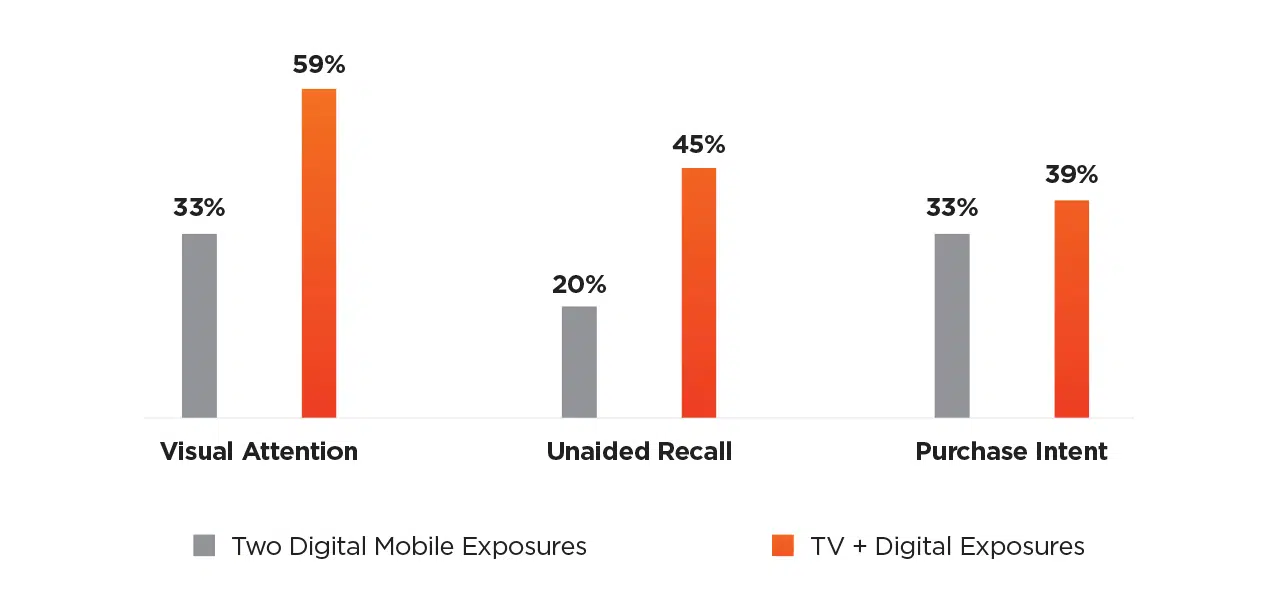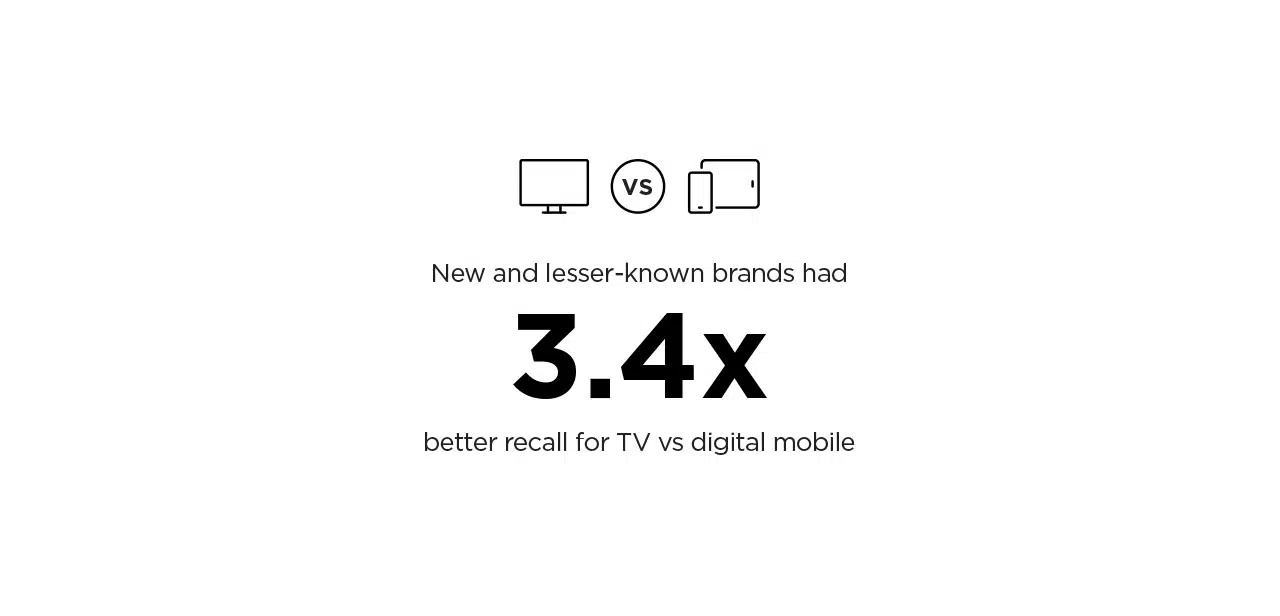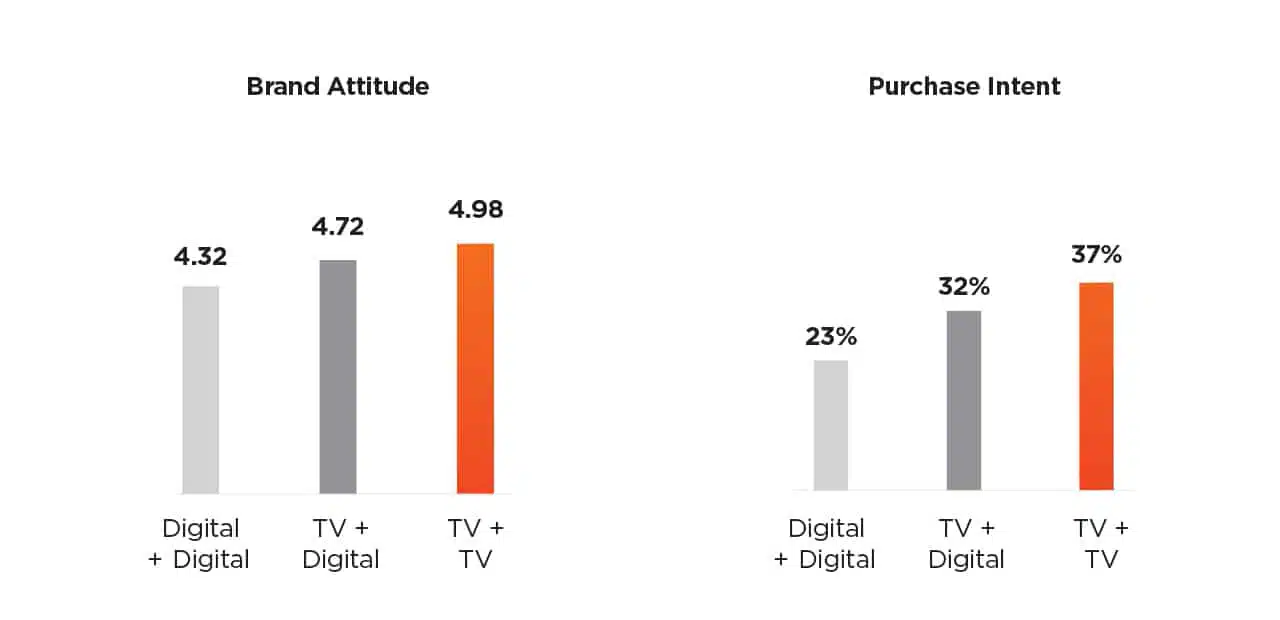Study Overview
Effectv worked with MediaScience to study how different types of ad exposure impact memory. A digital environment, consisting of either short-form YouTube clips or feed-based Facebook advertising (both on a mobile device), was tested with and against the TV environment, consisting of either traditional TV or connected TV (CTV) programming on a large screen. New and lesser-known or emerging brands were tested along with well-known brands to better understand the impact these advertising environments.
Multiscreen TV Enhances Digital Advertising
The study found that when a TV ad preceded a digital ad, participants viewed the TV ad 1.8 times longer, had +125% higher unaided brand recall, and had +18% higher purchase intent compared to participants that viewed two digital ads.
![]() What this means to advertisers:
What this means to advertisers:
The value of an impression is not equal across platforms. TV advertising can help enhance other advertising mediums due to its high attention and engagement which drives recall.
New and Lesser-Known Brands Benefit Most from TV Ads
Overall recall in the study was higher for all brands analyzed for TV compared to digital; however, the benefits from TV were even greater for new and lesser-known brands, as compared to well-known brands.
The better recall from TV upon first exposure may be explained by even greater attention and engagement with the new brand ads. Both cognitive attention and emotional engagement have been linked to memory formation and recall. When a TV ad preceded a digital mobile ad, cognitive attention and emotional engagement improved compared to two digital ads, demonstrating the brand-building power of TV. This same lift was not seen with the well-known brands tested, likely due to brand associations and attitudes already formed with those brands.
![]() What this means for advertisers:
What this means for advertisers:
If you are a new or growing brand, consider TV as a means for creating brand awareness and spurring recall.
New and Lesser-Known Brands Garner Trust with TV
The trust that TV garners may have contributed to a lift in brand attitude and purchase intent for new and lesser-known brands. Results show that participants who viewed ads in the TV environment showed higher “brand attitude,” translating to a lift in purchase intent compared to the digital environment. This same lift was not seen among well-known brands.
![]() What this means for advertisers:
What this means for advertisers:
TV has a far-reaching impact on building brands that extends throughout the funnel.
Summary
Build your brand with multiscreen TV. The memory effects of a digital environment alone are not enough to replace the brand-building power of TV. A digital-only strategy would erode brand strength and purchase consideration over time. Consider adding TV to your media plan to amplify your brand-building power.
To learn more about how TV ads impact brand recall, download the TV Makes Memories report.
Study Design
Comcast Advertising commissioned a consumer study to uncover why TV has the unique ability to drive engagement and build memories. The design of the study consisted of two cells with a total of 188 participants. The viewers were shown :30 second ads in different environments:
• Two ads in “mobile digital” environments (Youtube and Facebook in-feed ads)
• Two ads in “TV” environments (traditional TV + streaming)
• And one of each ad in a “Mobile digital environment” and “TV environment”
Viewers were also exposed to an even mix of both well-known brands and unknown brands. The participants were measured with a series of survey questions and biometrics including:
• Eye Tracking to quantify the visual attention to the ad by tracking where viewers are looking on the screen
• Cardiac Deceleration to quantify cognitive attention by tracking the slowing of heart rate
• Neurometric Intensity to quantify emotional response and engagement by measuring sweat secretion
Sources
Media Science, Effectv Study, March 2022, n=188. Analysis compares two ads on digital, TV + digital ad, and two TV ads. TV comprises a traditional TV ad &/or a streaming TV ad. Digital comprises Facebook & YouTube on a mobile device.







